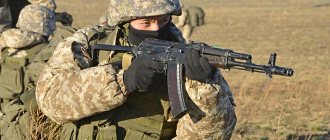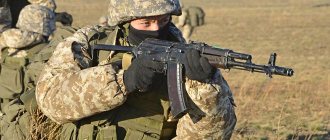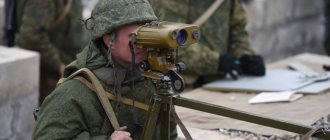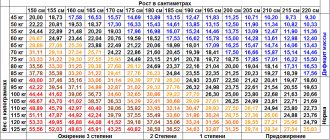The regulation on military medical examination, approved on July 4, 2013 by Government Decree No. 565, divides all conscripts into five categories according to the degree of suitability. The first on the list and the highest is category “A” - fit for military service without restrictions. That is, it implies iron health.
Reversal of a military ID with fitness category “A” stamped.
The category is indicated on the military ID and means that with it the conscript can be sent to any branch and type of troops, including the most complex. They are traditionally considered and called elite. These are the Navy and Marine Corps (Navy), Airborne Forces (Airborne), Military Space Forces (VKS, former Air Force, Air Force). Less well-known options are special and special forces troops, border troops, National Guard troops (Rosgvardia, former Internal Troops of the Ministry of Internal Affairs).
When they put category "A"
Category “A” is assigned according to the methodological requirements of the Schedule of Diseases. This is the official name of the annex to the Regulations on Military Medical Examination.
Evgeniy Godov
lawyer
On our website we regularly publish information about diseases from the law in the Directory of Diseases. The directory lists the most popular diseases and, in a simplified form, indicates which category a conscript should be classified into if he has this disease, taking into account the severity of its manifestation.
Ask a Question
Category “A” is excluded if the conscript has the following pathologies and disorders (for conscripts, the category in the Schedule is indicated in column I, also known as column I):
- infectious diseases and parasitic pathologies;
- neoplasms - except benign ones without dysfunction of the organ;
- diseases of the blood, hematopoietic organs and immune disorders;
- pathologies of the endocrine system (endocrine glands), metabolic disorders (metabolism) and nutritional disorders - except for first-degree obesity caused by excess nutrition (alimentary);
- any mental disorders, both psychotic and neurotic;
- any diseases of the nervous system, ear and mastoid process;
- any cardiovascular pathologies and circulatory disorders;
- any diseases of the respiratory system, skin and subcutaneous tissue;
- pathologies of the digestive system - except for caries, including on several teeth;
- problems with bones and muscles, connective tissue, systemic vasculitis;
- any disorders of the genitourinary system, consequences of injuries, other problems.
As you can see, from the three groups of diseases there are exceptions with which category “A” can be assigned. In addition, visual and hearing acuity, height, and body mass index are taken into account. Depending on these parameters, four subcategories are distinguished: A1, A2, A3 and A4. The larger the number, the fewer restrictions the Schedule of Diseases provides.
What diseases are included in category “B”
This list is determined by the same document. By looking at the “Schedule of Diseases”, you can familiarize yourself in detail with those diseases and pathologies that are included in category “B”. These include:
- a state of long-term compensation (at least one year) of pathological manifestations after an acute illness or closed head injury, provided there is no damage to the central nervous system and mental disorder;
- short-term mild asthenic state, which ended in complete recovery;
- somatoform or neurotic disorders that arose against the background of stress and ended with recovery;
- a single epileptic seizure that occurred more than 5 years ago or epileptiform activity detected by EEG, but taking into account the absence of clinical manifestations;
- inflammatory diseases of the central nervous system or their consequences without impairment of functionality;
- consequences of spinal cord or brain injuries, consequences of damage to the central nervous system from the influence of any external factors, provided there are no dysfunctions;
- pathologies of the peripheral nervous system also without impairment of functionality;
- moderately severe diseases of the orbit, eyelids, lacrimal ducts, conjunctivitis;
- mild and non-progressive diseases or consequences of burns and injuries of the cornea, sclera, lens, retina;
- slight myopia or farsightedness in one of the eyes, color weakness of 3-2 degrees or dichromasia;
- chronic diffuse otitis externa, unilateral microtia, eczema of the auricle or external auditory canal, as well as its congenital narrowing;
- left ventricular dysfunction in the absence of symptoms;
- congenital pathologies of the aorta, consequences of damage to the lymph nodes, aorta, arteries and veins without circulatory disorders;
- hemorrhoids, taking into account rare complications;
- some diseases of the respiratory system: non-purulent sinusitis, rarely exacerbating purulent sinusitis, diseases of the nasopharynx or nasal cavity with difficulty breathing, chronic pharyngitis;
- periodontal disease and mild periodontitis, gingivitis, stomatitis, congenital maxillofacial pathologies or consequences of injuries without dysfunction (respiratory, chewing, etc.);
- diseases of the esophagus, hernias, provided there are no functional impairments;
- gastrointestinal diseases with minor dysfunction;
- flat feet, defects of the finger or hand, lesions of large joints, bones, as well as diseases of the spine and their consequences without impairment of function;
- hydronephrosis, secondary pyelonephritis, cystitis, non-venereal urethritis without dysfunction;
- diseases of the male genital organs with minor clinical manifestations;
- consequences of fractures in the absence of impairment of functionality;
- moderate stuttering.
Suitability category "A1"
Fitness category for military service “A1” means the absence of even those exceptions listed above (caries and benign neoplasms without organ dysfunction).
The conscript must be between 170 and 185 cm tall and of normal weight - only first-degree alimentary obesity is allowed: with increased physical activity, the excess weight will go away on its own and very quickly. The conscript must also hear whispers at a distance of at least 6 meters, distinguish colors and even shades close to each other located nearby. Limit the viewing angle to no more than 20 degrees.
For level “A1” it is important that there are no injuries or serious illnesses in the past. Conscripts with such health can serve anywhere, but are usually sent to the airborne assault, marines, border troops and OSN troops.
Suitability category "A2"
It differs from “A1” in two details. Firstly, a conscript may have caries and benign neoplasms without organ dysfunction. And secondly, injuries and serious illnesses are acceptable if the young man has fully recovered, and all the consequences have disappeared by the time of conscription.
The remaining requirements - for height, vision, etc. - are the same as for the “A1” subcategory. There are only clarifications: for service on a submarine, the maximum height is 182 cm, and future members of tank crews must hear whispers from a distance of at least 4 meters (the general norm is 6).
In practice, with this category you will have to serve in the navy (both surface and underwater), in tank forces (for example, as a crew member), in artillery (as a driver of a self-propelled gun), in engineering troops (for example, as a driver of tractor-based vehicles and tanks).
Will they take you to the police?
According to practice, the Military Military Commission of the Ministry of Internal Affairs treats young people who want to enter the service much more strictly than the Military Commissariat Military Commissariat. There are frequent cases when category “A”, assigned by the military medical commission at the military registration and enlistment office, was refuted by the Ministry of Internal Affairs.
Much more opportunities are available to those citizens who have category “B1” in their military ID, and in addition to it, higher education. The chances increase literally several times if you have a legal diploma in your hands. Getting a job in the Ministry of Internal Affairs for any of the positions in the 3-4th group will not be problematic. This includes PDN inspectors, district police officers, OVO control panel security, OPPRIAZ inspectors, logistics service, etc. Over time, it is possible to transfer to other, better positions, since the requirements for their employees during re-examination are much lower than for those newly hired.
Suitability category "A3"
For this subcategory, minor vision problems are acceptable, which do not need to be corrected either for ordinary life or for military service. The general requirements are the same as for level A2.
Height – not less than 180 cm, normal weight or alimentary obesity of the first degree, visual field limitation of no more than 20 degrees. There are no requirements for perfect shade recognition; whispers can be heard at a distance of 5 meters.
With category "A3" you can serve almost anywhere, but most likely they will be sent to the Russian Guard (former Internal Troops of the Ministry of Internal Affairs), to chemical and guard units, to missile troops (for example, to operate a launcher), to motorized rifle troops, in common parlance still called infantry. There, a conscript can serve as a member of the crew or drivers of a combat vehicle or armored personnel carrier.
Suitability category "A4"
This category introduces one more assumption, in addition to vision problems, neoplasms, and caries. A conscript with level “A4” may have first-degree flatfoot. It is assumed that it does not interfere with military service, including wearing military boots.
The minimum height for category “A4” is 180 cm, normal weight or first degree nutritional obesity. The whisper can be heard from a distance of at least 5 meters. There are no requirements for color perception or viewing angle limitations.
With this category you can serve in any troops and units, except those listed above. That is, everywhere, except for those places for which conscripts from A1, A2 and A3 are selected.
The influence of a stamp on a military ID on later life
When applying for employment in any company, the employer requires men to provide a military ID , as required by law.
Having read the inscription “limitedly fit” or, even worse, “unfit”, the employer may suspect that the citizen has some kind of disease, which can radically affect his decision, and then a refusal to obtain a job will follow.
This is especially true for employment in law enforcement agencies and some private enterprises that need the most healthy and hardy employees.
Also, a bad category can contribute to refusal in:
- Obtaining certain categories of driver's licenses.
- Purchasing a license to carry a firearm.
Important. It is worth thinking about your future prospects and not “declining” from the army without real health problems, since a stamp on the ticket can ruin all your plans.
Category A in practice
The Regulations on the IHC and the Schedule of Diseases attached to it are quite detailed and clearly define which health state corresponds to fitness category “A” and its subcategories. But this is all, as they say, on paper, but what happens in practice?
In practice, the highest category, with which a conscript can be sent to the most difficult branches and types of troops, is actually assigned by default. If the medical documents submitted by the conscript do not contain any diagnoses, if no health problems are visually visible, if the conscript himself does not actively complain about his health. With all these “ifs”, doctors at the medical examination at the regional department of the military registration and enlistment office will thoughtlessly put at least subcategory “A4”.
At first glance, this approach may seem correct: why split hairs if nothing serious has been revealed. But the problem is that with category “A” a person can be sent, and given the understaffing in many units and subunits, they will most likely be sent to the troops, where iron health is really needed. And not on paper, but in reality.
And then there are possible options. In the best case, the marriage of the military medical commission will reveal the last medical filter - an examination before assignment to a military unit. And then a category correction is possible. At worst, no one will notice anything, and under conditions of increased load and stress, both physical and psycho-emotional, the defect, which would not normally attract attention, will worsen.
Some examples
The degree of the problem is also increasing because military-medical formalism knows no barriers. After category “A” comes level “B” – suitable with some restrictions. But the real state of health of a conscript with the highest category of fitness may generally correspond to the even lower category “B” - limited fitness. Of course, severe stuttering, excessive thinness or eczema are difficult to ignore, but there are many diseases and disorders to which it is not difficult for VVK doctors to turn a blind eye, especially if the conscript himself does not understand the whole situation.
For example, even at the age of 18, a person may have arterial hypertension, which, without a conclusion from a specialized hospital, the VHC therapist (there is no cardiologist on the commission at all) will simply ignore it. And with hypertension, of course, combat service is impossible. Under normal household stress, the disease may hardly manifest itself, and the body finds some kind of balance. Therefore, the young man does not think much about her and does not always complain about her. However, with a sharp increase in physical and mental stress, high blood pressure will make itself felt.
Obesity is another difficult diagnosis. The list of diseases for category “A2” and below specifies only the nutritional variant of this disorder. That is, caused by excess nutrition. However, it is impossible to understand the true cause of excess weight by sight. Height and overall build can also give a false impression. And obesity will be caused not by a lack of diet, but by hormonal disorders. However, it is almost always the nutritional type that is “revealed” during a medical examination.
That is why fitness category “A” is very insidious. In theory, it should be installed after a thorough health check, but in reality it is installed by default. And it can be very difficult to get the IHC to refer you to a hospital for a full examination, especially if you have not previously had regular visits to a doctor with such complaints. Of course, A1 and even A2 are placed relatively rarely, but both A3 and A4 are still suitable without restrictions.
How to move from one health category to another?
Quite often there are situations when doctors on the draft board deliberately overestimate the category of the future soldier. This is usually due to a shortage of personnel in certain troops, which must certainly be filled with the most suitable young men from all those who came in a given draft, even if they do not quite meet the requirements of this category.
It is very difficult to appeal such a decision and you will have to make a lot of effort to prove your unsuitability.
The situation is absolutely opposite for those who, on the contrary, do not agree with the reduced category and want to achieve distribution into the elite troops. It is easier to increase category A2 or A3 than to prove non-compliance with A1.
The preliminary examination during registration is not final, because during the conscription there will be another chance to show your compliance with category A1. Before conscription, you can have time to get yourself into suitable sports shape and lose weight, for example, if you had class 2 obesity and this was the reason for assigning not category A1, but only A2.
In other cases, if you disagree with the commission, you should:
- Undergo a follow-up examination, a referral for which must be requested from the commission.
- Independent control medical examination (IMC).
- Contact the judicial authorities with a claim and evidence, having previously notified the military commissariat, if previous methods did not bring the desired result.
Reference. In complex controversial situations, it would be a good idea to hire a lawyer qualified in these matters.











